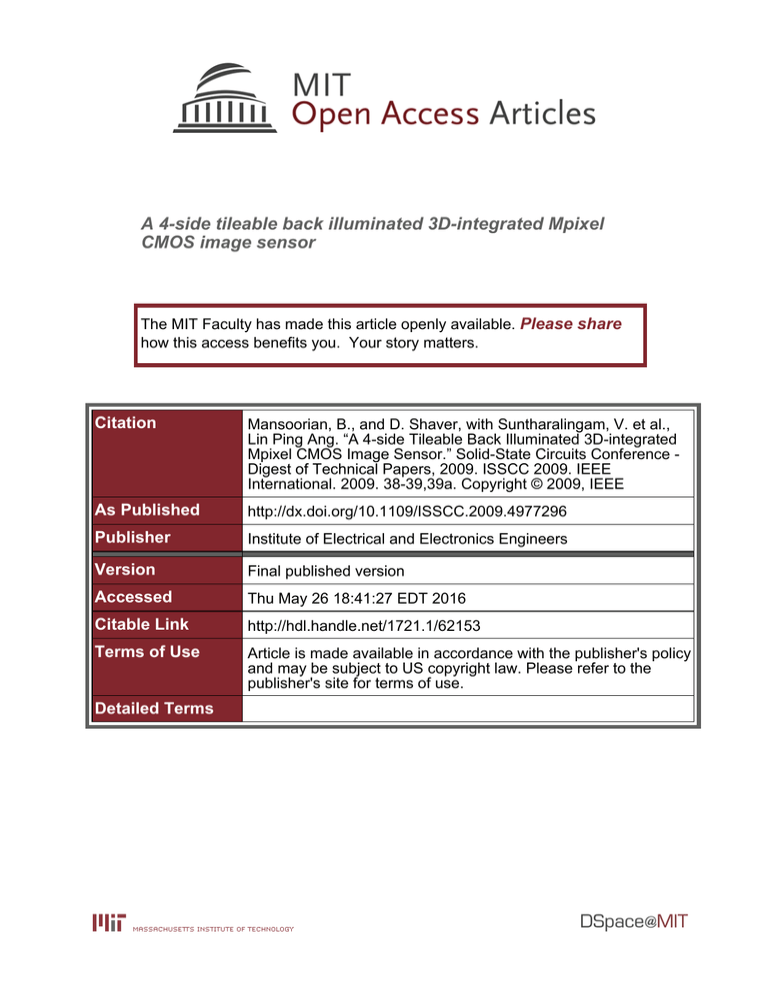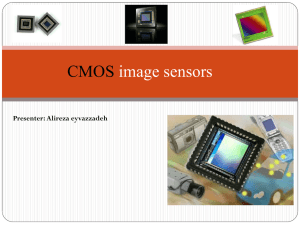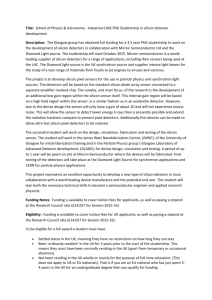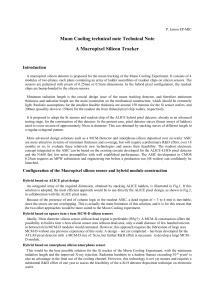A 4-side tileable back illuminated 3D-integrated Mpixel CMOS image sensor Please share
advertisement

A 4-side tileable back illuminated 3D-integrated Mpixel CMOS image sensor The MIT Faculty has made this article openly available. Please share how this access benefits you. Your story matters. Citation Mansoorian, B., and D. Shaver, with Suntharalingam, V. et al., Lin Ping Ang. “A 4-side Tileable Back Illuminated 3D-integrated Mpixel CMOS Image Sensor.” Solid-State Circuits Conference Digest of Technical Papers, 2009. ISSCC 2009. IEEE International. 2009. 38-39,39a. Copyright © 2009, IEEE As Published http://dx.doi.org/10.1109/ISSCC.2009.4977296 Publisher Institute of Electrical and Electronics Engineers Version Final published version Accessed Thu May 26 18:41:27 EDT 2016 Citable Link http://hdl.handle.net/1721.1/62153 Terms of Use Article is made available in accordance with the publisher's policy and may be subject to US copyright law. Please refer to the publisher's site for terms of use. Detailed Terms Please click on paper title to view Visual Supplement. ISSCC 2009 / SESSION 2 / IMAGERS / 2.1 2.1 A 4-Side Tileable Back Illuminated 3D-Integrated Mpixel CMOS Image Sensor Vyshnavi Suntharalingam1, Robert Berger1, Stewart Clark2, Jeffrey Knecht1, Andrew Messier1, Kevin Newcomb1, Dennis Rathman1, Richard Slattery1, Antonio Soares1, Charles Stevenson1, Keith Warner1, Douglas Young1, Lin Ping Ang3, Barmak Mansoorian3, David Shaver1 1 MIT Lincoln Laboratory, Lexington, MA Irvine Sensors, Costa Mesa, CA 3 Forza Silicon, Pasadena, CA 2 The dominant trend with conventional image sensors is toward scaled-down pixel sizes to increase spatial resolution and decrease chip size and cost [1]. While highly capable chips, these monolithic image sensors devote substantial perimeter area to signal acquisition and control circuitry and trade off pixel complexity for fill factor. For applications such as wide-area persistent surveillance, reconnaissance, and astronomical sky surveys it is desirable to have simultaneous near-real-time imagery with fast, wide field-of-view coverage. Since the fabrication of a complex large-format sensor on a single piece of silicon is cost and yield-prohibitive and is limited to the wafer size, for these applications many smaller-sized image sensors are tiled together to realize very large arrays [2,3]. Ideally the tiled image sensor has no missing pixels and the pixel pitch is continuous across the seam to minimize loss of information content. CCD-based imagers have been favored for these large mosaic arrays because of their low noise and high sensitivity, but CMOS-based image sensors bring architectural benefits, including electronic shutters, enhanced radiation tolerance, and higher data-rate digital outputs that are more easily scalable to larger arrays. In [4] we report the first back-illuminated, 1Mpixel, 3D-integrated CMOS image sensor with 8µm-pitch 3D via connections. The chip employs a conventional pixel layout and requires 500µm of perimeter silicon to house the support circuitry and protect the array from saw damage. In this paper we present a back-illuminated 1Mpixel CMOS image sensor tile that includes a 64-channel vertically integrated ADC chip stack, and requires only a few pixels of silicon perimeter to the pixel array. The tile and system connector design support 4-side abuttability and fast burst data rates. Figure 2.1.1 shows a schematic of the digital imaging tile’s 7-layer (or tier) physical structure. The first 2 tiers are a 3D imager, and the supporting 5 tiers are a multichip silicon stack. 3D integration is exploited in 2 different methods, each at different pitch scales. The 3D imager is a 2-tier 1024×1024 pixel image sensor array fabricated with 8µm-pitch, per-pixel 3D vias. The imager is vertically connected to the silicon stack through a gold stud bump array at 500µm pitch. Tier 1 consists of 100% fill factor, deep-depletion photodiodes, thinned to 50µm. Tier 2 consists of SOI-CMOS pixel readout and selection circuitry that is 3D-connected to Tier-1 photodiodes. Pixels extend to the edge of the 3D imager. A 5-layer silicon cube provides a digital system interface and also serves as a mechanical support to the thinned imager. Cube stack bus lines pass on two faces and an array of pogo pins provide a re-attachable flexprint/system interface connection. Both the silicon stack and system interface connectors fit within the shadow of the 3D imager, allowing close placement of neighboring tiles. Figure 2.1.2 describes the tile block diagram and pixel circuit. Tiers 1 and 2 comprise the pixel array. The silicon stack includes 2 silicon chips with 64, 12b pipelined ADCs, a timing sequencer, an image tile address encoder, bias generators, an Inter-Integrated Circuit (I2C) serial interface, and two 12b wide LVDS outputs operating at 512Mb/s/channel. Imager control is programmable to select readout mode (e.g. snapshot, rolling read, frame sub-sampling) and ADC timing and settings. The pixel consists of a photodiode, a reset transistor (RST), a snapshot transistor (S), a row select switch (RS), and a source follower. The analog signal from the 1024 columns is multiplexed onto 64 outputs that are fed through bump bonds to the ADCs in the silicon chip stack. 38 • 2009 IEEE International Solid-State Circuits Conference Only a few pixels of perimeter silicon surrounds the edge of the pixel array, since the CMOS support circuitry, traditionally located outside the pixel array, is now embedded within it. The Tier-2 pixel circuitry (8.0×8.0µm 2) is undersized relative to the Tier-1 photodiode footprint (8.3×8.3µm 2) and Tier-1 metallization is used as a vertical fanout. Figure 2.1.3 shows how the extra space is aggregated in blocks of 16×16 to create “streets” and “avenues” that are used for distribution of selection transistors, amplifiers, and ESD protection. In addition, a deep-trench process [5] is implemented to avoid physical damage to edge pixels and provide a continuous backside connection to the photodiode to permit deep-depletion operation for a broad spectral response. A cross-sectional SEM micrograph through several 8µm pixels of a functional active pixel imager is shown in Fig. 2.1.4. A 3D via connects Tier-2 fully depleted SOI CMOS metal-3 to Tier-1 (diode) metal-3, and a back-metal cap (BM-1) covers the 3D via plug. The uppermost level of back metal (BM-2) is thicker and is used for a bump-bonding interface. The 50nm-thick SOI transistor features can be seen near the top of the SEM. Pixel-to-pixel photodiode isolation is accomplished through implantation alone, thus realizing much lower dark currents than STI-isolated pixels. Figure 2.1.5 is a raw 1Mpixel image taken by the CMOS image sensor tile. The tile is temporarily mounted to a quartz wafer and the release holes provide ports for solvent removal of the quartz. The fixed-pattern noise is systematic and is related to the metal fanout and layout compression methods used to minimize seam loss. Imaging performance is observed to edge of the pixel array. Figure 2.1.6 summarizes characteristics for the back-illuminated sensor described in this paper. The chip’s overall performance is tested in an FPGAbased system. The board supports a 4-tile row and is stackable to support additional tile rows. It includes LVDS receivers, SRAM data storage, and a camera link interface to a remote computer. No on-chip noise reduction methods are employed; we are working to understand the noise performance. Other design revisions could improve the sensitivity and stack power dissipation. The principal pixel yield detractor arises from column or row dropouts; greater redundancy in architecture and layout would minimize vulnerability to single-point defects. Figure 2.1.7 is a photograph of the completed sensor tile showing the locations of the various circuit blocks. This is the first report of a 4-side-abuttable, vertically integrated, “photons-to-bits” image sensor tile; it achieves only a few pixels-equivalent of seam loss. This work demonstrates a path toward high-data-rate 3D image sensors and the methods developed here are extendable to other architectures, such as CCDs, APDs, or infrared focal-plane arrays. Ackowledgments: We thank the Lincoln Microelectronics Laboratory and the Advanced Silicon Technology 3D IC team. This work was sponsored by the United States Air Force under contract #FA8721-05-C-0002. Opinions, interpretations, conclusions, and recommendations are those of the author and are not necessarily endorsed by the United States Government. References: [1] K.B. Cho et al., “A 1/2.5 inch 8.1Mpixel CMOS Image Sensor for Digital Cameras,” ISSCC Dig. Tech. Papers, pp. 508-509, Feb. 2007. [2] N. Kaiser, “Pan-STARRS: a Wide-Field Optical Survey Telescope Array,” Proc. SPIE, vol. 5489, pp. 11-22, Oct. 2004. [3] J.L. Tonry et al., “Results from the Pan-STARRS Orthogonal Transfer Array (OTA),” Proc. SPIE, vol. 7021, 702105, July 2008. [4] V. Suntharalingam et al., “Megapixel CMOS Image Sensor Fabricated in ThreeDimensional Integrated Circuit Technology,” ISSCC Dig. Tech. Papers, pp. 356-357, Feb. 2005. [5] D.J. Young et al., “Deep-Trench Process Technology for Three-Dimensionally Integrated SOI-Based Image Sensors,” IEEE Int. SOI Conf., pp. 97-98, Oct. 2007. 978-1-4244-3457-2/09/$25.00 ©2009 IEEE Please click on paper title to view Visual Supplement. Please click on paper title to view Visual Supplement. ISSCC 2009 / February 9, 2009 / 1:30 PM 2 /LJKW ',PDJHU $O17RS&DS&KLS 5HURXWLQJ,QWHUSRVHU 6LOLFRQ6WDFN $'&&RQWURO&KLS0DVWHU $'&&RQWURO&KLS6ODYH $O1%RWWRP&DS&KLS [SL[HOV EXPSV *ROGUHURXWH VLGHEXVOLQHV WRWDODORQJIDFHV 32*2SLQV 6\VWHP,QWHUIDFH Figure 2.1.1 Schematic diagram of the 4-side-abuttable, 3D-integrated, CMOS imaging tile. Figure 2.1.2 Tile block diagram and pixel circuit. 7LHU 62,&026 62,GHYLFH ' 9LD 2[LGHERQG 7LHU %DFN,OOXPLQDWHGSKRWRGHWHFWRUWLHU PWKLFNKLJKUHVLVWLYLW\VLOLFRQ Figure 2.1.3 Die micrograph details of Tier-2 pixel readouts. CMOS addressing logic is embedded into space aggregated in streets and avenues. The rightmost image shows polysilicon and SOI active layers captured before formation of metal layers. Figure 2.1.4 Cross-sectional SEM micrograph through functional 3D-integrated active pixel imager. 3DUDPHWHU 3URFHVV 7HFKQRORJ\ 3L[HO $UUD\ VL]H &KLS VWDFN VL]H 3L[HO $UUD\ IRUPDW 'LRGH SL[HO VL]H 5HDGRXW SL[HO VL]H 3L[HO )LOO )DFWRU 7LOH )LOO )DFWRU 7LOHWR7LOH VHDP ORVV 3L[HO W\SH 3L[HO 2SHUDELOLW\ 6LJQDO FKDLQ FDSDFLW\ 5HVSRQVLYLW\ 'LRGH 'DUN FXUUHQW DW57 7HPSRUDO QRLVH 4XDUW]UHOHDVH KROHV P $QDORJ'LJLWDO &RQYHUVLRQ &RQYHUVLRQ WLPH 'LJLWDO LQWHUIDFH 'LJLWDO GDWD UDWH 7HVWHG IUDPHUDWH ',PDJHU 3RZHU $'&&RQWURO 3RZHU 9DOXH 7LHU SQ GLRGH LQ FP )=6L 7LHU P 0,7//62, &026 9 6WDFN P 7RZHU 30 9 PP + [ PP 9 PP + [ PP 9 [ P + [ P9 P + [ P9 IHZ SL[HOV 76QDSVKRW ! 9NH 9H HVW I$SL[HO P9UPVH UPV FKDQQHOV SHU FKLS ELW SLSHOLQHG $'& PVHF 7ZRELWZLGH RXWSXWV 0ELWVHF /9'6 ISV P:0SL[VHF P:0SL[VHF &RPPHQW $GGUHVV FLUFXLWU\ HPEHGGHG LQ³VWUHHWV´ DQG³DYHQXHV´ %DFN LOOXPLQDWHG )HZ SL[HO ERUGHU VXUURXQGLQJ SL[HO DUUD\ SOXV PHFKDQLFDO SODFHPHQW HUURU 5ROOLQJ UHDG DQG VXEVDPSOLQJ DOVR VXSSRUWHG (VWLPDWHGIURP VHQVH QRGH FDSDFLWDQFH $'&FKLS VHWLQ,UYLQH 6WDFN GXW\ F\FOH IRU $'& $WISV $WISV Figure 2.1.5 Captured raw image from digital tile at 10fps, with digital data read out in 1ms. Figure 2.1.6 Performance summary. DIGEST OF TECHNICAL PAPERS • Please click on paper title to view Visual Supplement. 39 Please click on paper title to view Visual Supplement. ISSCC 2009 PAPER CONTINUATIONS PWKLFN 'LPDJHU 3L[HOV OD\HU $'&&RQWUROVWDFN )UDPHIRU SRJRSLQIOH[SULQW FRQQHFWRU Figure 2.1.7: Photo of 4-side-abuttable, 3D-integrated, digital imaging tile. • 2009 IEEE International Solid-State Circuits Conference 978-1-4244-3457-2/09/$25.00 ©2009 IEEE Please click on paper title to view Visual Supplement.






